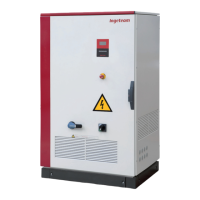
Do you have a question about the Ingeteam Ingecon Sun Power Series and is the answer not in the manual?
| Category | Inverter |
|---|---|
| Brand | Ingeteam |
| Series | Ingecon Sun Power |
| Frequency | 50 Hz / 60 Hz |
| Protection Degree | IP65 |
| Communication Interface | RS-485, Ethernet (Optional), Wi-Fi (Optional) |
Essential safety precautions and cautions for personnel, covering qualified personnel and general risks.
Lists required safety gear such as goggles, footwear, helmets, and gloves for safe handling.
Details the function of the inverter and its role in converting solar DC to grid AC power.
Lists models with and without transformers and their respective AC output voltages.
Specifies suitable environmental conditions like temperature, humidity, and air quality for unit installation.
Explains the importance of maintaining adequate space for air circulation around the unit for cooling.
Provides crucial steps for safe handling and unpacking to prevent damage to the unit's mechanical characteristics.
Explains the meaning of various hazard symbols like danger, caution, and hot surface warnings.
Outlines fundamental safety measures for qualified personnel performing electrical installation, start-up, and maintenance.
Details safety measures for accessing the unit, including disconnection procedures and authorized access points.
Covers essential installation requirements including ventilation, workspace, and cable specifications for safe setup.
Provides instructions and dimensional requirements for securely fixing the inverter unit to a concrete pad.
Provides detailed procedures and safety precautions for making all electrical connections to the unit.
Specifies the mandatory sequence for connecting various electrical components like grounding, auxiliary supply, and PV array.
Details the safe procedure for connecting the inverter to the photovoltaic array, including voltage precautions.
Explains the optional kit that provides mains power to the inverter's control unit during periods of low PV array power.
Describes the grounding kit that provides PV array protection via a thermomagnetic circuit breaker.
Outlines essential pre-startup checks of wiring, DC feed, and AC feed components for proper operation.
Details the procedure for the initial startup and verification, including checking parameters and alarms.
Details routine maintenance tasks including checking enclosure integrity, cable connections, and cleaning ventilation filters.
Explains the function of each key on the keypad and the meaning of different LED indications for status and alarms.
Details the display layout, including date, time, node number, and operational parameters like voltage and power.
Guides users on accessing and interpreting various monitoring screens showing inverter parameters like power, voltage, and current.
Provides instructions for adjusting settings such as date, time, language, grid limits, and ground connection.
Explains the meaning of Green, Orange, and Red LED indications and their relation to unit status and alarms.
Provides a detailed list of all possible alarms, their codes, shutdown reasons, and a brief description of each issue.
Outlines a systematic approach to diagnose and resolve incidents, including checking alarms and performing electrical checks.
Details how to identify and troubleshoot insulation faults, distinguishing between external and internal unit issues.
Provides a step-by-step guide for safely replacing the heavy electronics block, including necessary PPE and tools.
Explains the layout and function of each terminal on the various terminal strips for connections and signals.